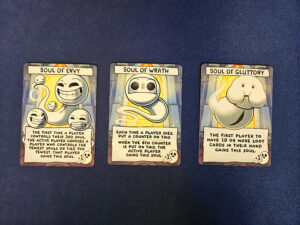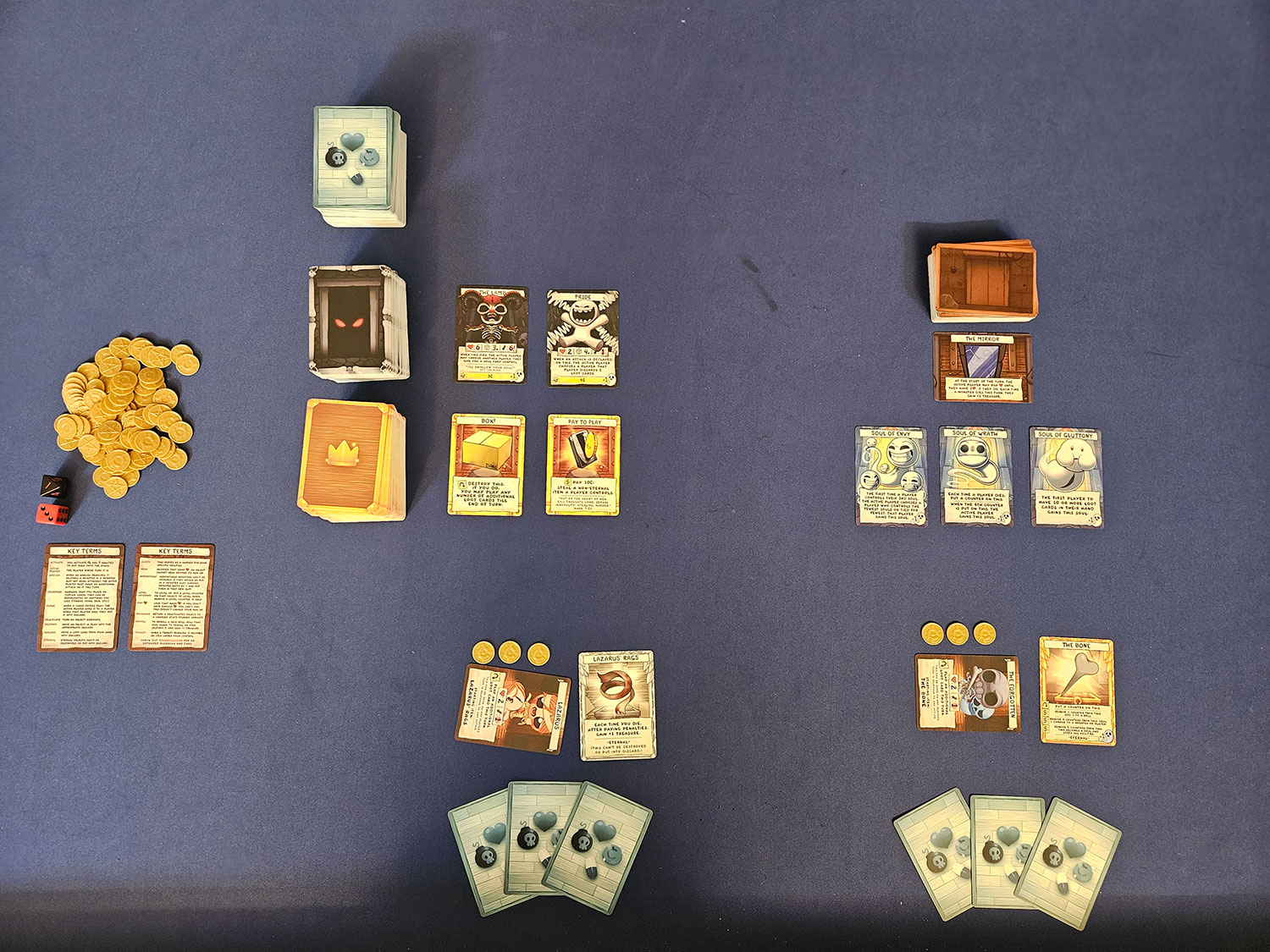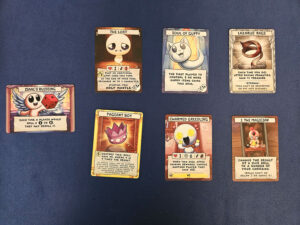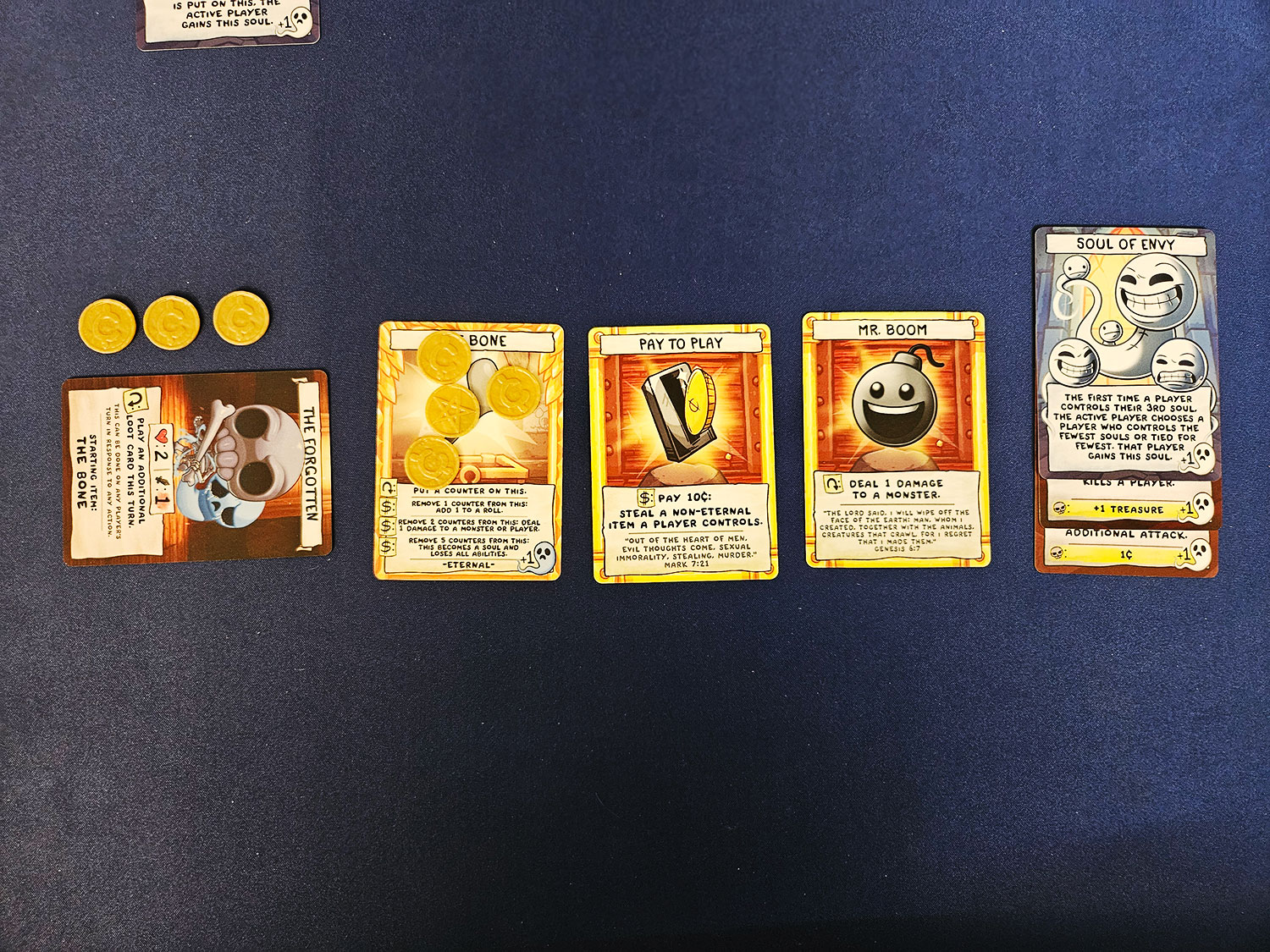 The world of video-game-to-board-game adaptations seems to grow every day. What used to be a market of cheap, tired designs aimed at grabbing a known audience has turned into a unique design space.
The world of video-game-to-board-game adaptations seems to grow every day. What used to be a market of cheap, tired designs aimed at grabbing a known audience has turned into a unique design space.
Trendsetters like Frostpunk, Slay the Spire, and Bloodborne have really shown how the video games of inspiration can be translated to the tabletop with distinct theses from their digital counterparts. But can The Binding of Isaac: Four Souls live up to that high watermark?
Gameplay Overview:

In The Binding of Isaac: Four Souls, 1-4 players will be challenging one another to collect, well, four souls. In gameplay terms, this (usually) means killing four monsters. In order to aid players in their victory, the game is full of loot and treasures, all aimed at helping players improve their odds of victory in one way or another. Some items will provide you rerolls for your combat rolls, others will give the player more life or the ability to heal, etc… Each victory will also award you with more money to spend on more items, leading to a juicy snowball effect of power.
Where this game really shines is with the high variance introduced by both the sheer number of cards, as well as the many different variants included in the deck. There are different characters that let players start with asymmetric player powers. There are Room Cards that apply a random effect to the combat encounters. There are Bonus Souls that players can compete for, all with wildly different requirements.
Spend wisely, fight ferociously, and have luck on your side to collect your four souls to win The Binding of Isaac: Four Souls.

Game Experience:
The gameplay rundown should not come as a surprise to those who have played the video game. The Binding of Isaac formula remains strong with its transition to the tabletop. Relying on the luck of the loot to determine the strength of your run is where the video game shines brightest, and the board game emulates that feeling quite well.
The other major facet that made the video game as popular as it is is the power creep the best runs achieve. Progression in The Binding of Isaac is never linear: it is always exponential. Let’s look at an example: let’s say there’s an item that increases your attack power dramatically when your Health is lower. Well, The Binding of Isaac has several different resources that work similarly to Health. Instead, maybe you replace your Health with Soul Hearts, which work nearly identically but, crucially, you can have as many as you want without decreasing the strength of this particular item.

Now combine that strength, that power, with about ten other items of that power.
This phenomenon of powerful combos is where The Binding of Isaac: Four Souls is strongest. When the luck of the draw is in your favor just enough, you can reach the random, powerful heights of the video game. The main issue with the board game is its length. Because the victory condition is essentially “kill four monsters”, each player’s build doesn’t often have enough time to reach the proper chaos of the video game, where players will often fight 10+ bosses.
Where the board game starts to fall apart as an adaptation is with its multiplayer interactions. This game has been compared to Munchkin by most other reviews I’ve read, and honestly, it feels like an apt comparison. I’d say it falls close in line with Talisman as well, though much shorter. It just feels weird for players to be so encouraged to be so directly harsh to one another. I’m not averse to these types of interactions, but for a video game that plays so much like an engine builder, it would feel more apt for this game to be an engine builder without players going at each other so much.

The player interaction feels even more out of place when the weaknesses of the video game are taken into account. I’ve gushed about how much fun it is to have a mighty character in a run of the video game, but oftentimes it takes 5-10 attempts before one of these broken and powerful runs happens. By making players able to affect one another so much in the board game, it often dampens any attempts to become as powerful as everyone around the table wants to be.
I think it’s important to note that there are also co-op and solo variants here. In my opinion, if you’re a super fan of the video game, these are the game modes for you. These encapsulate the video game experience without shaping the game into something else entirely.
It’s also important to note that I was sent and played The Binding of Isaac: Four Souls with its expansion, Requiem. However, I did not review the expansion separately from the base game because the expansion is simply a “more” expansion: more Loot Cards, more Monsters, etc… The biggest additions from the Requiem expansion are the co-op and solo modes discussed above, the Bonus Souls, and the Room cards.

Final Thoughts:
Overall, if you’re a fan of The Binding of Isaac, I’d be hard pressed to not recommend The Binding Of Isaac: Four Souls. Not only is it a highly thematic adaptation of the video by the creator of the video game himself, but the card flavor text and art call back to the items in the video game in really fun and unique ways. I’d recommend checking out the co-op and solo modes, but if you have friends who are used to the harsh and random experiences of Munchkin or Talisman, the multiplayer mode is worth checking out. If you’re not a Binding of Isaac fan, play Talisman or Munchkin. I don’t believe this product is worth exploring if you’re not a fan of the video game.
Final Score: 3 Stars – A game for those who love the video game, nothing more.
 Hits:
Hits:
• Tons of variety
• Top-tier adaptation
• Powerful, wacky player powers
Misses:
• Confusing for non-video game players
• Short, awkward rulebook
• Niche audience





















